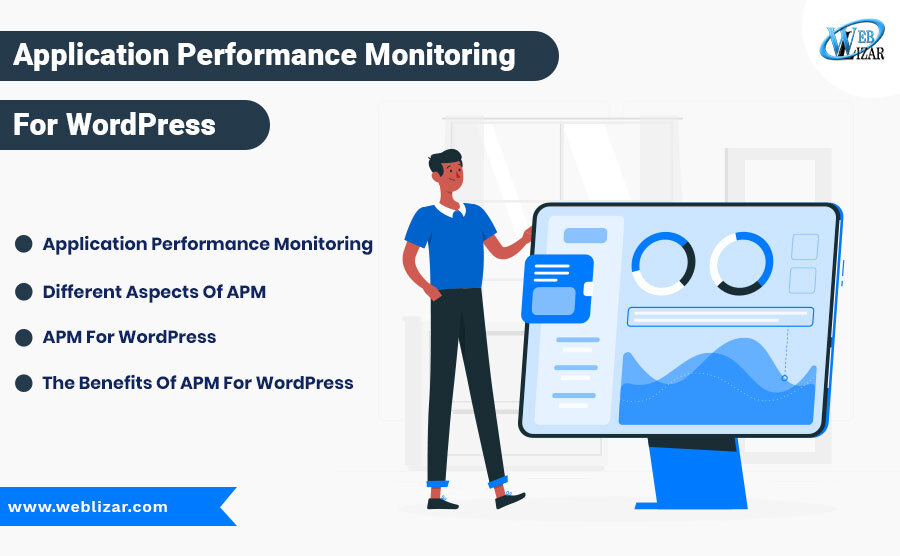Speed is a vital component of modern utilities, especially for applications and websites. In particular, WordPress websites experiencing lags and downtimes don’t contribute to excellent user experiences. After all, slowness in online portals becomes detrimental to site owners in more ways than one.
Ensuring high performance and excellent end-user experience defines an app or portal’s success. Application performance monitoring can help assure both site owners and visitors to smooth out digital experiences.
Application Performance Monitoring
The basis of application performance monitoring (APM) allows site owners to monitor different key performance indicators (KPIs) by looking at hardware and software metrics. The data provided by an APM can help you analyze various concerns and windows of opportunity, ranging from application codes to business transactions.
APM for WordPress websites, particularly for online business owners, helps users understand digital trends, isolate and solve anomalies, and acquire actionable insights for accurate and fast resolutions to problems. Using a WordPress plug-in or application to help with APM allows site administrators to use different aspects, hoping to improve end-user experiences.
Different Aspects Of APM
APM has many uses, spanning different categories. For example, it can help individuals start an online business or allow digital influencers to spread brand awareness. Nonetheless, WordPress site owners can apply different APM aspects to produce strategies, implement actions, and achieve various goals. These characteristics include:
- Digital user experience monitoring
- Business transaction profiling
- Application code-level diagnostics
- Infrastructure Visibility
- Application deep-dive analytics
Also Read: Which Is The Best Performance Monitoring Tool?
Answering the question, “Why is the WordPress site slow?” needs a correlated understanding of the different APM aspects. The strategy gained should adopt various ideas to help users automate site diagnoses and streamline performance troubleshooting.
For example, looking at one graph can help you target a site issue. The chart should have a sufficient amount of data to isolate problems and ensure the efficient performance of different WordPress site elements.
APM For WordPress
Using APM strategies is a practical choice for many site owners, including administrators. You can use APM tools to help you combat site bottlenecks, providing optimized WordPress experiences for all users regardless of hierarchy. Note that different APM tools exist. However, these apps tend to use industry-standard monitoring features for different WordPress site owners.
Some of these features may include:
- Dashboard overview
- List transaction types and traces
- Database management
- URL drill-downs
- Data explorers
- Custom query systems
Use these features to help you quickly determine the current health and state of your website. For example, use the information displayed on the APM app’s dashboard to check for different information, such as:
- Overload load time
- Apdex score
- Error rate
- Throughput
- Transactions
Also Check Out: Everything You Need to Know About Server Monitoring
APM app users may also exercise other website monitoring practices by looking at the recent events found in dashboard overviews. Here, you should find various alerts and warnings to indicate problems in WordPress sites.
For example, a recent alert shows that a site speed index has a threshold of 0.5 seconds. Hence, you might receive a notification if the website’s speed goes over that ceiling.
The Benefits Of APM For WordPress
APM for WordPress entitles end-users, along with administrative and other lower-tiered users, to different advantages. But, some benefits stand out from the rest. Some of these advantages are:
- Minimal site downtime
- Increased profits for online businesses
- Site apps and plug-ins work at optimal levels
All of these advantages can translate to better user experience at various levels. For instance, site administrators of online businesses can use gathered data to create actionable strategies for improving customer satisfaction. In turn, monitoring website performance can help make customers happy, allowing the organization to improve profit returns.
Moreover, APM helps online businesses achieve continuity. It’s because the monitoring tools and strategies can provide adequate information, helping site owners maintain optimal server and website uptime.
Hence, it minimizes the risks of issues, like unhappy customers, decreased client loyalty, and low employee productivity. Moreover, using reliable APM apps and techniques can curb and improve falling profits.
In-house IT teams may use APM to see a customer- and site-related incidents in real time. Thus, users with varying administrative levels may use the information to develop creative and distinct solutions to improve profitable online activities while decreasing various risks.
Check out the latest post: The Secret To Ranking Higher On Google In 2024
Conclusion – Application Performance Monitoring For WordPress
APM for WordPress can help prevent different app and site issues, such as lags, disconnections, and unhappy customers. Remember to use reliable monitoring strategies and tools to reduce different risks and potential pitfalls significantly.
If you’re not in a hurry, take the time to research noteworthy APM apps. Note that the program you choose should provide more positives than negatives to your online portal.
FAQs”
what are the benefits of application performance monitoring?
There are many benefits of application performance monitoring, Application performance monitoring provides early issue detection, enhances user experience, ensures system reliability, optimizes resource usage, enables data-driven decision-making, reduces downtime, and proactively resolves bottlenecks.
How do I monitor my WordPress performance?
You can monitor your WordPress performance by using plugins like WP Performance Score Booster or WP Rocket, leveraging built-in tools like Query Monitor or New Relic, optimizing images and caching, and regularly checking site speed with tools like GTmetrix or Google PageSpeed Insights.
How do you measure application performance?
You can measure application performance using metrics such as response time, throughput, error rate, resource utilization, and user satisfaction. This is often done using monitoring tools, profiling, load testing, and user feedback.

